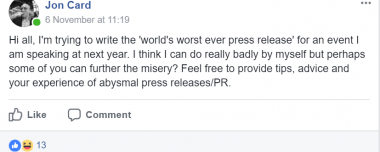How to run a crowdfunding campaign
 At the end of 2017, Full Story Media got involved in the crowdfunding campaign to raise funds for six-year-old Kyra Warrell to undergo life changing surgery. The campaign raised over £50,000 in less than two months. Here are some of the lessons learned.
At the end of 2017, Full Story Media got involved in the crowdfunding campaign to raise funds for six-year-old Kyra Warrell to undergo life changing surgery. The campaign raised over £50,000 in less than two months. Here are some of the lessons learned.
Rima and Neil Warrell needed to raise £58,000 in 58 days for their daughter to have life changing surgery. Kyra had been born with a rare condition which the NHS couldn’t treat.
But Rima had refused to give up. She scoured the internet and found a surgeon in the US, who could help. However, in order to make the surgery affordable, the operation had to be performed in Israel in February 2018.
The family raided all piggy banks and launched a campaign on Chuffed.org. When we met them they had just over £8,000. The clock was ticking…
Choose a dedicated campaigner
Someone has to take the lead in a crowdfunding campaign, and this was Rima Warrell. She was articulate and knowledgeable; able to confidently talk to the press, potential donors and backers. But, most importantly, she was available and responsive. Campaigning is a test of resolve and dedication – there are no breaks, you simply have to keep going.

Get your ducks in a row
Crowdfunding is a sales and marketing exercise. Slick campaigns are months in the making. Slogans are written, plans are drawn and investors are courted long before the campaign is published online. None of that was true for @StepWithKyra. However, the Warrells rallied friends, family, the local community, media and their MP to the cause and played a serious game of catch-up.
Create a compelling narrative
This was where Full Story came in. We created a press release: Brighton Mum vows to fight to save her daughter’s leg. This was sent across the media and gained traction in the local and national media and, most crucially, the Israeli press.
A good press release is a story – a human story. We told of the family’s struggle and the hopes of a little girl. There were a lot of quotes from Rima, explaining their plight. Also, it was filled with key facts - every fact is a potential angle for a journalist to take.
Great imagery
You can’t run a media campaign without pictures. Thankfully, we had a very cute, six-year-old girl, and a photogenic Mum. “Get a photoshoot”, we advised. A photographer friend with a good camera was found and soon the faces of Kyra and Mum Rima were all over the place. Kyra was spread across the front page of the Brighton Argus.
The viral effect
A good story travels. The local media took the story first, but then it took off in the Jewish and Israeli media. Kyra Warrell was featured in the Jerusalem Post. Soon, donations came flooding in from the global Jewish community.
Keep the story going
Once a story is out there, it takes on a life of its own. Those following it and those involved will require constant updates on developments. Social media is very useful in this respect. Ensure your chosen channels are filled with key information and kept up to date. You’ll gain supporters from unexpected quarters. When someone supports you, make sure they feel the love.
Kyra’s campaign raised over £50,000 and she was able to have her surgery. She will require more operations in the future. You can support Kyra now
Writing 'the world's worst ever press release'
I am attempting to write the world's worst ever press release.
It's for an event I'm currently working on where I'll be teaching business owners how to communicate effectively with the media.

I thought an example demonstrating all of the things not to do would be an amusing way to get started.
So then I thought that a little crowdsourcing might help me. After all, if I'm going to create a true monstrosity - the sort of thing that will leave my fellow journalists writhing in agony, literally convulsing at their desks - some input from my colleagues seemed like a sensible idea.
I belong to a Facebook group where journalists offer help and advice to one another, and also complain about all the people who've upset them recently - may their ears burn.
I posted the following:

Within 48 hours, my post had gained over 200 responses. Fueled by a mixture of fury and glee, journalists offered a seemingly endless number of ways to really screw up a press release.
The group is closed, so I won't be publishing the posts directly. Also, the bilious hatred expressed by some members of the group towards certain practices of the PR industry could, all too easily, be taken out of context.
However, here are five of the best ways to really antagonise a journalist, in case you ever need to.
Incorrect names
Journalists take a dim view of emails where their names are spelt incorrectly, are addressed 'dear sir' (especially women) or messages that begin with [insert name here]. Cheery chit chat about the weather and signing off with xx also grates.
PointLess caPitalisation
The tendency for some in the PR industry to capitalise words that neither start sentences or are proper nouns draws much criticism. They don't much like exclamation marks, either.
PDFs
Press releases sent as attachments draw much ire. However, none more than the dreaded PDF which, for many journalists, has come to stand for: 'Please Do F***-off.
Burying the story
It would seem journalists like to be able to discern a tale early on, rather than several paragraphs in.
Marketing speak
Telling a journalist about your "bespoke, highly tailored, innovative solution" can lead to twitchiness.
Jon Card will be offering training sessions to businesses this year to help them get press, see upcoming events here.





